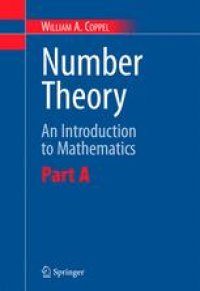
Ebook: Number Theory: An Introduction to Mathematics: Part A
Author: William A. Coppel (auth.)
- Tags: Number Theory, Linear and Multilinear Algebras Matrix Theory, Special Functions
- Year: 2006
- Publisher: Springer US
- Language: English
- pdf
Undergraduate courses in mathematics are commonly of two types. On the one hand are courses in subjects—such as linear algebra or real analysis—with which it is considered that every student of mathematics should be acquainted. On the other hand are courses given by lecturers in their own areas of specialization, which are intended to serve as a preparation for research. But after taking courses of only these two types, students might not perceive the sometimes surprising interrelationships and analogies between different branches of mathematics, and students who do not go on to become professional mathematicians might never gain a clear understanding of the nature and extent of mathematics. The two-volume Number Theory: An Introduction to Mathematics attempts to provide such an understanding of the nature and extent of mathematics. It is a modern introduction to the theory of numbers, emphasizing its connections with other branches of mathematics. Part A, which should be accessible to a first-year undergraduate, deals with elementary number theory. Part B is more advanced than the first and should give the reader some idea of the scope of mathematics today. The connecting theme is the theory of numbers. By exploring its many connections with other branches, we may obtain a broad picture.
Audience
This book is intended for undergraduate students in mathematics and engineering.
Undergraduate courses in mathematics are commonly of two types. On the one hand are courses in subjects—such as linear algebra or real analysis—with which it is considered that every student of mathematics should be acquainted. On the other hand are courses given by lecturers in their own areas of specialization, which are intended to serve as a preparation for research. But after taking courses of only these two types, students might not perceive the sometimes surprising interrelationships and analogies between different branches of mathematics, and students who do not go on to become professional mathematicians might never gain a clear understanding of the nature and extent of mathematics. The two-volume Number Theory: An Introduction to Mathematics attempts to provide such an understanding of the nature and extent of mathematics. It is a modern introduction to the theory of numbers, emphasizing its connections with other branches of mathematics. Part A, which should be accessible to a first-year undergraduate, deals with elementary number theory. Part B is more advanced than the first and should give the reader some idea of the scope of mathematics today. The connecting theme is the theory of numbers. By exploring its many connections with other branches, we may obtain a broad picture.
Audience
This book is intended for undergraduate students in mathematics and engineering.
Content:
Front Matter....Pages i-xv
The expanding universe of numbers....Pages 1-96
Divisibility....Pages 97-150
More on divisibility....Pages 151-207
Continued fractions and their uses....Pages 209-260
Hadamard’s determinant problem....Pages 261-303
Hensel’s p-adic numbers....Pages 305-339
Back Matter....Pages 341-468
Undergraduate courses in mathematics are commonly of two types. On the one hand are courses in subjects—such as linear algebra or real analysis—with which it is considered that every student of mathematics should be acquainted. On the other hand are courses given by lecturers in their own areas of specialization, which are intended to serve as a preparation for research. But after taking courses of only these two types, students might not perceive the sometimes surprising interrelationships and analogies between different branches of mathematics, and students who do not go on to become professional mathematicians might never gain a clear understanding of the nature and extent of mathematics. The two-volume Number Theory: An Introduction to Mathematics attempts to provide such an understanding of the nature and extent of mathematics. It is a modern introduction to the theory of numbers, emphasizing its connections with other branches of mathematics. Part A, which should be accessible to a first-year undergraduate, deals with elementary number theory. Part B is more advanced than the first and should give the reader some idea of the scope of mathematics today. The connecting theme is the theory of numbers. By exploring its many connections with other branches, we may obtain a broad picture.
Audience
This book is intended for undergraduate students in mathematics and engineering.
Content:
Front Matter....Pages i-xv
The expanding universe of numbers....Pages 1-96
Divisibility....Pages 97-150
More on divisibility....Pages 151-207
Continued fractions and their uses....Pages 209-260
Hadamard’s determinant problem....Pages 261-303
Hensel’s p-adic numbers....Pages 305-339
Back Matter....Pages 341-468
....